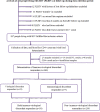Immunological and virological discordance among people living with HIV on highly active antiretroviral therapy in Tigray, Northern Ethiopia
- PMID: 34118891
- PMCID: PMC8196496
- DOI: 10.1186/s12879-021-06206-4
Immunological and virological discordance among people living with HIV on highly active antiretroviral therapy in Tigray, Northern Ethiopia
Abstract
Background: People living with human immunodeficiency virus (HIV) with immuno-virological discordant responses are at an increased risk to develop acquired immunodeficiency syndrome (AIDS) and severe non AIDS events which are risk factors for death. This study was aimed to assess prevalence of immuno- virological discordant responses and associated risk factors among highly active antiretroviral therapy (HAART) users in Tigray, Northern Ethiopia.
Methods: A cross sectional study was conducted from September to December 30, 2016 on 260 people living with HIV who started first line HAART from January 2008 to March 2016 at Mekelle hospital and Ayder comprehensive specialized hospital. Baseline and follow-up clinical data and CD4+ result were collected from patient charts. Besides, socio-demographic data and blood samples for CD4 + count and viral load measurement were collected during data collection period. Fisher's exact test, bivariate and multivariate logistic regressions were used for data analysis. P-value < 0.05 with 95% CI was considered as statistically significant.
Result: Among the 260 study participants, 8.80% (95% Confidence Interval (CI) =8.77-8.84%) and 2.70% (95% CI = 2.68-2.72%) had virological and immunological discordant responses, respectively with an overall immuno-virological discordance response of 11.50% (95% CI = 11.46-11.54%). The median age of the study participants at HAART initiation was 35 (IQR: 28-44 years). More than half (58.1%) of the study participants were females. Age at or below 35 years old at HAART initiation (AOR ((95% CI) = 4.25(1.48-12.23), p = 0.007)), male gender ((Adjusted Odds Ratio (AOR) (95% CI) =1.71(1.13-1.10), p = 0.029)), type of regimen given ((AOR(95% CI) = 0.30 (0.10-0.88), p = 0.028)) and good treatment adherence ((AOR (95% CI) = 0.12 (0.030-0.0.48), p = 0.003)) were associated risk factors for virological discordant response. Likewise, immunological discordant response was associated with tuberculosis co-infections (p = 0.016), hepatitis B virus co-infections (p = 0.05) and low CD4+ count (≤100 cells/μl) at baseline (p = 0.026).
Conclusions: Over all, immuno-virological discordance response was 11.5% in the study area. Males, low baseline CD4+ count, poor/fair treatment adherence, and TB and HBV co-infections were significantly associated with higher immuno-virological discordance. We recommend that decision of patient treatment outcome, regimen change and patient management response should be done using trends of both viral load and CD4+ count concurrently.
Keywords: HAART discordant responses; HIV; Immunological discordance; Northern Ethiopia; Virological discordance.
Conflict of interest statement
We declare that we have no conflict of interest.
Similar articles
-
Virological failure and associated factors among patients receiving anti-retroviral therapy in Ethiopia: A systematic review and meta-analysis.BMJ Open. 2024 Nov 28;14(11):e087569. doi: 10.1136/bmjopen-2024-087569. BMJ Open. 2024. PMID: 39613423 Free PMC article.
-
Factors associated with immunological and virological discordant responses to highly active antiretroviral therapy among adult HIV positive individuals in Ethiopia: A cross-sectional study.Medicine (Baltimore). 2021 Nov 24;100(47):e27624. doi: 10.1097/MD.0000000000027624. Medicine (Baltimore). 2021. PMID: 34964727 Free PMC article.
-
Virological and immunological failure of HAART and associated risk factors among adults and adolescents in the Tigray region of Northern Ethiopia.PLoS One. 2018 May 1;13(5):e0196259. doi: 10.1371/journal.pone.0196259. eCollection 2018. PLoS One. 2018. PMID: 29715323 Free PMC article.
-
Predictive factors associated with virological failure among adult patients living with HIV on first-line highly active antiretroviral therapy in Southeast Oromia, Ethiopia: a case-control study.BMJ Open. 2025 Apr 17;15(4):e093797. doi: 10.1136/bmjopen-2024-093797. BMJ Open. 2025. PMID: 40250876 Free PMC article.
-
Treatment failure and associated factors among people living with HIV on highly active antiretroviral therapy in mainland China: A systematic review and meta-analysis.PLoS One. 2023 May 2;18(5):e0284405. doi: 10.1371/journal.pone.0284405. eCollection 2023. PLoS One. 2023. PMID: 37130123 Free PMC article.
Cited by
-
Virological failure and associated factors among patients receiving anti-retroviral therapy in Ethiopia: A systematic review and meta-analysis.BMJ Open. 2024 Nov 28;14(11):e087569. doi: 10.1136/bmjopen-2024-087569. BMJ Open. 2024. PMID: 39613423 Free PMC article.
-
Status and factors associated with patient activation and its relationship with HIV clinic outcomes among Yi minority people living with HIV in Liangshan, China: a cross-sectional study.Front Public Health. 2023 Jun 15;11:1114561. doi: 10.3389/fpubh.2023.1114561. eCollection 2023. Front Public Health. 2023. PMID: 37397752 Free PMC article.
-
Immunovirological discordance among people living with human immunodeficiency virus at a center in Western India: A retrospective study.Indian J Sex Transm Dis AIDS. 2023 Jan-Jun;44(1):15-19. doi: 10.4103/ijstd.ijstd_121_22. Epub 2023 Jun 6. Indian J Sex Transm Dis AIDS. 2023. PMID: 37457539 Free PMC article.
-
Immunovirological discordance among female sex workers who start antiretroviral therapy in Burkina Faso.BMC Infect Dis. 2022 Feb 3;22(1):117. doi: 10.1186/s12879-022-07109-8. BMC Infect Dis. 2022. PMID: 35114959 Free PMC article.
-
The effect of oral probiotics on CD4 count in patients with HIV infection undergoing treatment with ART who have had an immunological failure.Immun Inflamm Dis. 2023 Jun;11(6):e913. doi: 10.1002/iid3.913. Immun Inflamm Dis. 2023. PMID: 37382253 Free PMC article. Clinical Trial.
References
-
- Moore DM, Hogg RS, Yip B, Wood E, Tyndall M, Braitstein P, Montaner JS. Discordant immunologic and virologic responses to highly active antiretroviral therapy are associated with increased mortality and poor adherence to therapy. J Acquir Immune Defic Syndr. 2005;40(3):288–293. doi: 10.1097/01.qai.0000182847.38098.d1. - DOI - PubMed
-
- AIDS info. Panel on Antiretroviral Guidelines for Adμl ts and Adolescents. Guidelines for the Use of Antiretroviral Agents in Adμl ts and Adolescents with HIV. Department of Health and Human Services, 2019. Available at http://www.aidsinfo.nih.gov/ContentFiles/AdμltandAdolescent.pdf.
-
- Hirigo AT, Fenta DA, Bala TB, Bule SG, Gemechu MR. Trends of Immuno-virological response among HIV-infected patients receiving highly active anti-retroviral therapy at Hawassa, Southern Ethiopia. Clin Med Res. 2015;4(4):104–110. doi: 10.11648/j.cmr.20150404.13. - DOI
MeSH terms
Substances
LinkOut - more resources
Full Text Sources
Medical
Research Materials


